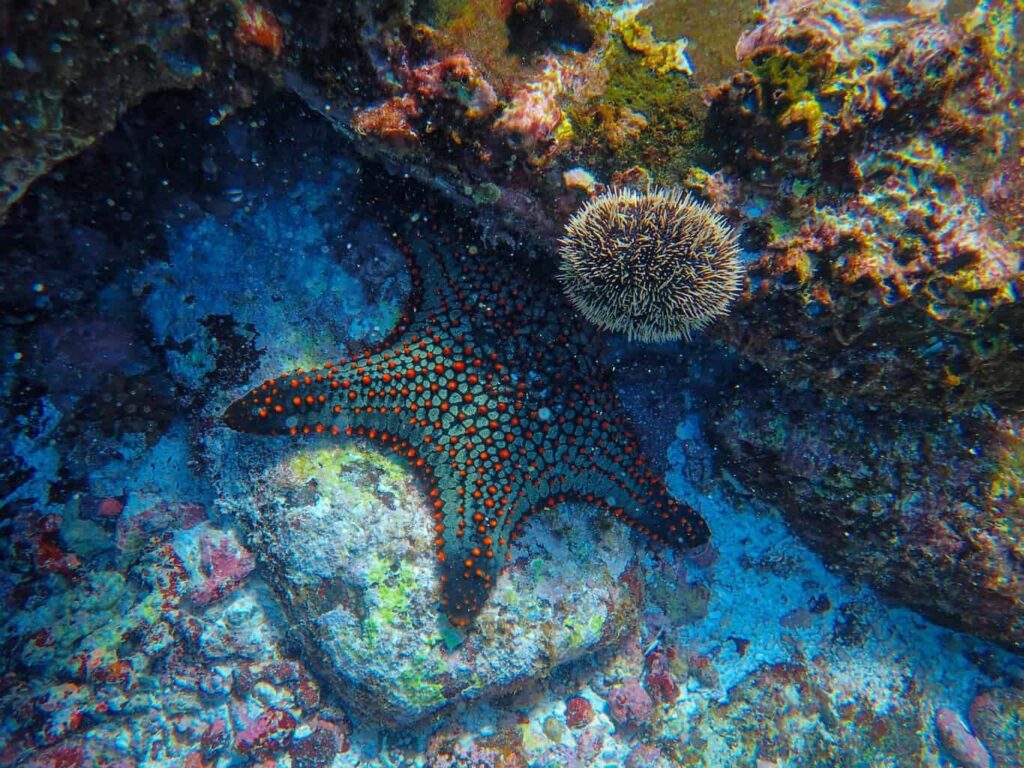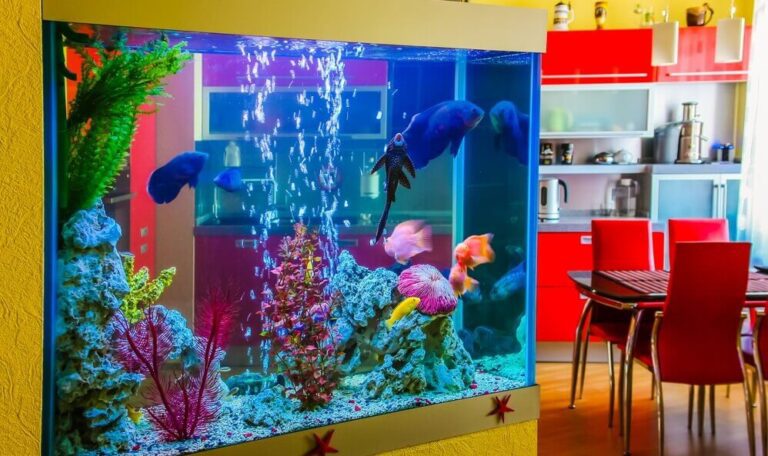Reef tanks are getting more and more popular day by day. Though some of the system and ideas revolving around such tanks keep changing, what remains constant is the live rock. Be it artificial or natural, live rock happens to be the most important part of a saltwater aquarium or a reef tank.
You may be having many questions in your mind revolving around the live rock, including why do you need live rock, what are the different types, and how to cure live rock for your aquarium, and so on. I shall try to answer as many of these questions as possible so that you have a better understanding of live rock and can make a wise decision for your aquarium.
What is live rock?
 When you set up your own reef tank, you are not simply keeping corals or fishes but are actually creating your own little ecosystem in the aquarium. Live rock is a very important part of that ecosystem.
When you set up your own reef tank, you are not simply keeping corals or fishes but are actually creating your own little ecosystem in the aquarium. Live rock is a very important part of that ecosystem.
If you are just exposed to this hobby recently the term can be a little confusing for you. Well, as I learned in school and as you must have too, rocks are non-living things. Live rocks are also not alive but are home to many, many bacteria and other little beneficial invertebrates. These rocks serve as the biological and physical backbone of the reef present in our tank.
The purpose of live rock
Live rock for reef or marine tank is important because it serves many important functions and I believe the most important one is that of biological filtration for your aquarium or tank. Tanks are closed systems and the food that you add in it for its inhabitants needs to exit the tank.
Biological filtration is absolutely necessary for the longevity and health of the lives in the tank. Now, the question is how a rock can do that. It cannot even move so how can it clean your tank. Well, the breaking down of food and its exit happens in a few steps which I shall share with you right away.
- Firstly, the cleanup crews and small filter feeders like spaghetti worms and emerald crabs and other invertebrates that live within and on the live rock consume the fish waste and also the food that they have not eaten.
- Since the waste particles are now smaller, they get converted into nitrite, phosphate, and ammonia. Live rock helps convert these toxic chemicals into not-so harmful products like nitrate.
- These nitrates are then assimilated by the various nitrifying bacteria and algae present within the rocks.
- In the final stage, most of the nitrates get converted into nitrogen gas and gets out of the tank through the gas exchange at the surface of the water.
If your tank produces more waste than is possible for your live rock to handle then you may need to add more live rock or keep changing the tank water periodically.
Types of live rock
There are different types of live rock that you can choose from for your saltwater aquarium. I shall now share with you a brief description of some of the common types.
Fiji Live Rock
These are the most popular type. They are lightweight and porous, and I have noticed these rocks vary greatly from one supplier to another. If you need these rocks urgently and get them air-shipped then they can cost you a lot. It will be best to get them boat-shipped. One more important thing I would like you to know is that all Fiji live rock needs curing.
Aquacultured live Rock
These are amongst the most environmental-friendly live rock. Most countries like the Bahamas, the Marshall Islands, the United States, and many other nations have banned the practice of breaking coral reefs apart and exporting them as live rock.
Aquacultured live rock is a better option as they are sourced right from within the earth, generally calcium carbonate, and are kept in the ocean so that new life grows within and on it. The aquacultured live rock has different density, shape, and size depending on which farm you get it from. Some such rocks need little to no curing at all.
Pukani Live Rock
This is a new type of rock from Fiji. It is lightweight and porous. It has good shapes and generally is shipped in slightly bigger pieces. Such rocks can leach phosphates easily back into your tank. Curing Pukani rock can take more than 6 months.
Tonga Branch Live Rock
These rocks are dense and thus reduce the types of life that may survive within it. Tonga Branch rocks come in interesting shapes, can make a good addition, but should not be the sole live rock you add to your tank.
Artificial Live Rock
Synthetic or man-made live rock is comparatively new. It is environmental-friendly and sustainable. Depending on which company you opt for these rocks from they can look artificial and fake. The artificial rocks may look nice and bright to few but they can never contain the many beneficial organisms that actually make a live rock live.
Live rock vs. dry rock
Before I dive more into this section (live rock vs. dry rock) first let me help you know what a dry rock is. Well, it is nothing but a wet live rock that first has been dried and cleaned and then used. However, both bad and good bacteria will grow on it gradually.
Now back to the topic – live rock vs. dry rock.
Life is already thriving in or on live rock and this makes a tank look more beautiful. I love watching the growth of life in my reef tank. This looks so colorful and stunning. Dry rock, on the other hand, has been cleaned, though growth will happen in this case as well. But that will need a couple of months at least.
Algae will be growing on both these rocks but algae growing on the live rock are most suitable for an aquarium.
Yet another difference is the price. As the dry rock is easier to get and also weigh less, it is more economically priced.
Both these rocks will make your aquarium look more beautiful and will contribute to the enjoyment and health of your fishes. Which one you select amongst these two is more a matter of personal preference.
Why do you need to cure live rock?
It is important to cure live rock to make sure the aquatic environment in your aquarium remains healthy. The biodiversity that is found on every transported live rock goes through some extent of natural die off, particularly damaged or delicate flora and fauna. When going through this process, these encrusting organisms produce waste materials in a high amount.
If proper curing is not done, toxic compounds and pollutants like ammonia can be released into the water and this will affect the health of your entire tank.
How much rock do you need for your aquarium?
When I started this hobby, the old rule that was followed was to add about a pound or two of live rock for each gallon of the tank’s volume. For instance, if you owned a 55-gallon tank then the advice was to add live rock of about 55 to 110 pounds.
A question that later arose in my mind was 100 pounds of heavier, denser rock would take up far less space compared to a 100 pounds of less dense rock. So, was it okay to exactly follow the old rule?
You may follow the old rule but I would personally suggest starting by adding 10 to 20 pounds of live rock no matter what the volume of your tank. If you are wondering why so little, then it is because the rest of your requirement will be met by dry rock.
Wait for some time, see how your aquarium looks, and if need be, you can keep adding a little more of live rock, until your tank looks exactly the way you desire.
How to remove unwanted pests from your live rock
Firstly, fill a bucket with saltwater (gravity of 1.035 – 1.040) and submerge your new live rock in it for about a minute. Invertebrates like bristle worms, mantis shrimp, and crabs will get out of the rock, into the bucket.
Remove your rock from the bucket and decide which invertebrates you would want to include to your tank. The rest can be discarded. If bristle worms still remain attached to your rock then you can use a pair of tweezers to remove them. You can follow this method after or before curing the new rock.

How to cure live rock: step-by-step Guide
For live rock cure, you will need –
- An empty tank or a bucket or any type of water container
- Saltwater Test Kit (ammonia, nitrite & nitrate)
- Live rocks
- Heater
- Air pump or powerhead
Now the steps:
- Mix some saltwater and fill up the tank. A glass tank is preferred as it will help you to observe the rocks and remove any unwanted or dying thing.
- Use the heater to keep water temperature around 80 Fahrenheit and put the rocks in it. Place the airline of air pump or the powerhead to introduce a nice water flow through the rocks. You may use a wave maker as well but not necessary and a overkill I should say.
- You need to periodically test the water using a saltwater test kit. At first you can test only for ammonia. Within a few days you will observe an ammonia spike. This will be followed by a nitrite spike and finally a nitrate spike.
- After few days ammonia and nitrite readings should be zero. This indicates that the biological filtration is established and the rocks have sufficient bacteria colony to consume ammonia and nitrite. It is okay to have some nitrate in the water.
- You need to keep testing the water. Curing of the rock is complete when you will see no more nitrate increase in the tank. This indicates that no more nutrient is being released in the water. The dying of residual corals and sponges are done. The rocks are cured and safe to place in the main tank.
- During the whole process keep an eye on the rocks and check if anything unknown or unwanted creature is released in the tank. Get rid of it immediately.You can use a brush to rub the rocks to get rid of anything dying there.
- The whole process will take around 4 to 6 weeks.
- Do a final check up for any pests or unwanted creatures and place the rocks in your main aquarium. You have successfully cured the rocks!
Lighting during the curing process
You should not light the live rocks with high-intensity lighting during the curing procedure as this can result in an algae bloom. Keeping it in a dark or semi-dark place is good to prevent any algae growth on the rocks. You may choose actinic lights for it as well.
If you have chosen actinic lighting, the photo-period needs to be nothing more than 5 hours a day. The idea here is to offer light which is enough to keep the corals and coralline algae alive, but they should not result in any algae blooms.
To Conclude
Just bringing home a fish tank is not enough, you also have to take good care of it. You need to make sure the lives within the tank are healthy and happy and for the purpose, one of the responsibilities you have to fulfill is selecting the right live rock and curing it. And now that you know so much about live rock and its curing process, things will definitely be easy-breezy for you.







